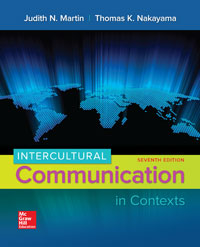Test Bank For Intercultural Communication in Contexts Judith Martin 7 edition
CHAPTER 2
THE HISTORY OF THE STUDY OF INTERCULTURAL COMMUNICATION
MULTIPLE-CHOICE QUESTIONS
1. How did Edward T. Hall contribute to the origins of intercultural communication?
a. Hall developed a technology that increased our ability to communicate with people in other cultures.
b. Hall explored the relationship between a person’s national identity and values orientations.
c. Hall helped describe the relationship between language learning and conflict.
d. Hall identified and wrote about cultural differences in nonverbal communication.
Ans: d
2. Which of the following is true of the development of the intercultural communication area of study?
a. It originated with scholars looking for practical answers to help overseas workers.
b. This area of study is almost the same as the research done in the field of sociology.
c. It began as a result of people’s displeasure over the foreign relations concerning the Vietnam conflict.
d. The primary goal of scholars was to develop theories that described intercultural communication processes.
Ans: a
3. Researchers who use the _____ approach to studying intercultural communication are interested not only in understanding human behavior but also in changing the lives of everyday communicators.
a. rhetorical
b. interpretive
c. critical
d. functionalist
Ans: c
4. Which of the following approaches to studying intercultural communication assumes that human behavior is predictable and that culture is a variable that can be measured?
a. the functionalist approach
b. the interpretive approach
c. the critical approach
d. None of the answers is correct.
Ans: a
5. Which of the following is primarily used in the critical approach to studying intercultural communication?
a. field studies and observations
b. questionnaires and observations
c. textual analysis of media
d. interviews and experiments
Ans: c
6. The social science approach to studying intercultural communication is also called the:
a. variable approach.
b. qualitative approach.
c. functionalist approach.
d. collectivist approach.
Ans: c
7. Researchers using a critical perspective attempt to explain:
a. how macrocontexts such as political structures influence communication.
b. how specific cultural differences might predict communication conflicts.
c. intercultural communication by providing in-depth descriptions of cultural patterns.
d. variations in communication strategies used by people from different cultures.
Ans: a
8. One limitation of the social science approach to studying intercultural communication is:
a. the potential to place too much focus on the historical and political contexts while ignoring the relationships between the people being studied.
b. the lack of empirical measures for assessing communication strategies.
c. the possibility that the methods used in this approach are not culturally sensitive.
d. the inability to compare communication interactions between different cultural groups.
Ans: c
9. The goal of the _____ approach to studying intercultural communication is to predict specifically how culture influences communication.
a. critical
b. interpretive
c. rhetorical
d. social science
Ans: d
10. The study of how people use personal space is called:
a. pathetic.
b. psychology.
c. linguistics.
d. proxemics.
Ans: d








Reviews
There are no reviews yet.